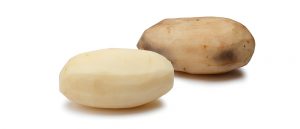Late this fall, the USDA approved for commercial use a genetically modified potato. These GMO potatoes, which were created by Simplot and named Innate, are actually the second generation of GMO potatoes to be approved by the federal government for commercial use. The first generation of the potato has been available commercially for growers now for over a year. It is expected that the second generation potatoes will get approval from the FDA, as well as the EPA, in January of 2017. Such approval will allow the seed to be cultivated and grown in the United States.
The Innate potatoes have been genetically engineered to deal with some specific issues facing the potato industry. They have reduced incidences of bruising and black spots. They also produce less of a potential carcinogen when fried (you know, the cooking technique used to make all those delicious french fries). The second generation potato will also be resistant to the pathogen that caused the infamous Irish potato famine. They will also be able to stay in cold storage for longer periods of time without incurring discoloration.

The Innate potato is unique, but not just because it is a GMO crop. It is the second genetically modified crop to gain commercial approval that offers benefits for the consumer, instead of just farmers.
The Arctic Apple was approved in 2015 for commercial use by all three federal agencies involved in regulating genetically modified crops: the EPA, USDA, and FDA. The apple is modified so that it does not brown after being cut like a non-GMO apple. By simply “turning off” the genes that cause the browning, Okanagan Specialty Fruits was able to create an apple that will keep its color. The fruit, which just had its first commercial harvest this year, should open the market for cut, fresh apples.
Aside from being consumer-friendly though, the Innate potatoes and the Arctic Apples may signal a switch in how use of the technology is being perceived.
Previously, the benefits of GMOs were seen primarily by farmers. Round-Up Ready crops, which were the first GMOs commercially available on the market, are plants that are modified to be resistant to the herbicide Round-Up. This allows farmers to effectively use the herbicide to kill weeds that threaten the plant and yields, while not harming the plant.
Of course, even the Round-Up Ready and Bt traited GMOs have benefits for consumers, even if these are not seen directly. For example, herbicide resistant crops have resulted in farmers spraying less herbicide overall, given that one application is usually sufficient to target those pesky weeds. While that does not necessarily impact them directly, consumers indirectly benefit from having lower application rates in the environment of more toxic herbicides.
But not truly realizing the benefits and impacts of these genetically engineered crops may be one of the reasons that consumers have developed a negative perception about them.
Many activist groups opposed to biotechnology, such as March Against Monsanto, have been able to capitalize on this difference. Round-Up Ready crops are often demonized as solely benefiting Monsanto, who originally produced the herbicide Round-Up and created the patented resistance gene, as a way for the company to make money. Consumers are sold the line that the technology is being foisted on farmers against their will, and that they are now negatively dealing with the consequences. That the technology may benefit farmers is never mentioned and probably would not resonate with consumers.
However, the new wave of consumer-friendly GMOs may go a long way in highlighting the benefits and potential of the technology, as well as reducing the stigma surrounding them. While some may ask why we need a non-browning apple, the convenience of such an item has the potential to outweigh some of the negative smear campaigns. The same is true with the Innate potatoes. When consumers realize the benefit of reduced food waste from a non-bruising potato, the benefits may start to outweigh previously held notions about the technology.
Biotechnology has the potentially to be an extremely powerful tool to help agriculture best some of its biggest hurdles. But before we get that far, we may need to step back and allow consumers to also appreciate the benefits of this science.
For videos about the consumer and environmental benefits of Simplot’s Innate potatoes, visit www.innatepotatoes.com/newsroom/videos.



